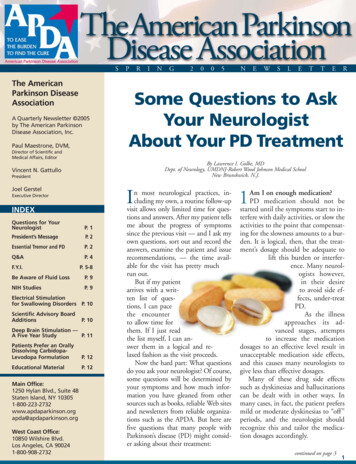
Transcription
SThe AmericanParkinson DiseaseAssociationA Quarterly Newsletter 2005by The American ParkinsonDisease Association, Inc.Paul Maestrone, DVM,Director of Scientific andMedical Affairs, EditorPJoel GerstelIExecutive DirectorINDEXQuestions for YourNeurologistP. 1President’s MessageP. 2Essential Tremor and PDP. 2Q&AP. 4F.Y.I.P. 5-8Be Aware of Fluid LossP. 9NIH StudiesP. 9Electrical Stimulationfor Swallowing Disorders P. 10P. 10Deep Brain Stimulation —A Five Year StudyP. 11Patients Prefer an OrallyDissolving CarbidopaLevodopa FormulationP. 12Educational MaterialP. 12West Coast Office:10850 Wilshire Blvd.Los Angeles, CA 900241-800-908-2732NG2005NEWSLETTERBy Lawrence I. Golbe, MDDept. of Neurology, UMDNJ-Robert Wood Johnson Medical SchoolNew Brunskwick, N.J.PresidentMain Office:1250 Hylan Blvd., Suite 4BStaten Island, NY arkinson.orgISome Questions to AskYour NeurologistAbout Your PD TreatmentVincent N. GattulloScientific Advisory BoardAdditionsRn most neurological practices, including my own, a routine follow-upvisit allows only limited time for questions and answers. After my patient tellsme about the progress of symptomssince the previous visit — and I ask myown questions, sort out and record theanswers, examine the patient and issuerecommendations, — the time available for the visit has pretty muchrun out.But if my patientarrives with a written list of questions, I can pacethe encounterto allow time forthem. If I just readthe list myself, I can answer them in a logical and relaxed fashion as the visit proceeds.Now the hard part: What questionsdo you ask your neurologist? Of course,some questions will be determined byyour symptoms and how much information you have gleaned from othersources such as books, reliable Web sitesand newsletters from reliable organizations such as the APDA. But here arefive questions that many people withParkinson’s disease (PD) might consider asking about their treatment:1Am I on enough medication?PD medication should not bestarted until the symptoms start to interfere with daily activities, or slow theactivities to the point that compensating for the slowness amounts to a burden. It is logical, then, that the treatment’s dosage should be adequate tolift this burden or interference. Many neurologists however,in their desireto avoid side effects, under-treatPD.As the illnessapproaches its advanced stages, attemptsto increase the medicationdosages to an effective level result inunacceptable medication side effects,and this causes many neurologists togive less than effective dosages.Many of these drug side effectssuch as dyskinesias and hallucinationscan be dealt with in other ways. Inmany cases, in fact, the patient prefersmild or moderate dyskinesias to “off ”periods, and the neurologist shouldrecognize this and tailor the medication dosages accordingly.continued on page 31
ESSENTIAL TREMORAND PDOFTEN CONFUSEDBy Melissa Houser, MDScripps Clinic, La Jolla, Calif.Tremors occur in a variety of illnesses,but two common neurological conditions associated with tremor areParkinson’s disease and essentialtremor. Although these two disorders differ in many ways, doctors andpatients sometimes confuse them.Essential tremor may begin quiteearly, even in childhood, but mostpeople notice it becoming a nuisancein their 50s, and it may worsen withage. The tremor often involves thehands, head and voice.The hands may shake when performing any simple action. Generally,if the hands are not moving, thetremor is absent (but there are exceptions to this rule).The cause of essential tremor isunknown, although there is a stronghereditary component — so much sothat many doctors use the term “familial tremor.” This tremor disorder isgenerally considered benign becauseit is not associated with a progressiveneurological illness leading to significant disability.Many people with severe forms ofthe tremor find eating or drinkingwithout spillage impossible. Theymay experience depression, embarrassment and subsequent social isolation. For a person who requires verysteady hands to perform a job, or forthose in the public eye, the tremorcan, indeed, lead to disability.The good news is that this tremorcan be treated. Although there is no“cure” for essential tremor, severalmedications may help alleviate it.Most physicians usually prescribe oneor two drugs to help; a blood pressure drug called propanolol (Inderal )and/or an antiseizure drug calledprimidone (Mysoline ).Some patients take the medication daily, but some may reserve taking the drugs for a certain need, such2continued on page 9P R E S I D E N T ’ SM E S S AG EDear Reader,I think it is most appropriate that Parkinson’s Awareness Monthcomes in the spring, because spring is the season of hope.APDA’s original objectives, to heighten the country’s awareness of the disease and to raise funds for research, have grownwell beyond its founders’ greatest aspirations, and today we areproud of our role as the international leader in PD educationand awareness.Through nationwide walk-a-thons and a myriad other special events at which literatureis disseminated, educational lectures and symposia, and a library of free publications on allaspects of the disease in English, French, Spanish, Portuguese, Chinese and Italian, APDAis the principal national and international source of information about the disease. Indeed,approximately one quarter of our expenses (50 percent, if you add our Information & Referral Centers) are for educational programs.In 1994, APDA formalized a working relationship with the Associazione ItalianaParkinsoniani (AIP), a small organization of 3,000 Italians with PD, caregivers, friends andmedical professionals. Today AIP has 23 offices across Italy, more than 25,000 members,sponsors annual national conventions for patients and their families, and has recently established a Young Onset Parkinson’s Group.Upon their collaboration, the two organizations established an Electronic International Parkinson’s Disease Resource Guide with 13 initial participants, which has grown to become the 25-member World Parkinson Disease Association.In recent years, as the public learned that some very visible persons in highly respectedand responsible positions were persons with Parkinson’s, there evolved a greater understanding of the condition and respect for those with it. Add to that insight, new drug therapies, successful surgical interventions, and the growing areas of research, we have reasonsto look toward a brighter future.In this issue you will read about some of the efforts made by volunteers across the country to raise awareness as well as funds for PD research. APDA’s individual Chapters andI&R Centers used their collective talents and energies to package fund-raising and educational activities in fun-filled events.In addition, their leaderships requested formal proclamations from state and local officials to promote awareness. To name a few: George McHugh, president of the GraniteState Chapter arranged for New Hampshire Gov. John Lynch to issue and present a“World Parkinson Awareness Day” proclamation last month, and Dianne Johnson, RN,San Antonio, Texas, coordinator, led a bus filled with patients and caregivers to City Hallto receive a proclamation in March. Florida’s Suncoast Chapter, led by Ginna Bernard,arranged for endorsements by Gov. Jeb Bush.New Mexico’s chapter president Bob Dunagan and his wife, Charlene, who was diagnosed in 1979, sent 123 solicitations to more than 20 major tribes or pueblos in NewMexico, as well as to New Mexico Gov. Bill Richardson. Among the nations contacted,each with its own governor, were the Navajo, Mescalero Apache and Jicarrilla Apache.In FYI, you will read a poem written by 9-year-old Bernadette Bianchi from Coloradofor her grandmother. It falls into the “out of the mouths of babes” department.We all wish you a happy spring filled with the hope and promise of more than perfectweather and gardens.Sincerely,Vincent N. GattulloPresident
Some Questions to Ask Your Neurologist about Your PD Treatment continued from page 12Would a dopamine agonist bebetter than carbidopa/levodopa(Sinemet ) for me?In general, patients who areyounger than 65 or 70, have no thinking difficulties and are in the earlystages of PD do better on “dopaminereceptor agonist” drugs such as pergolide (Permax ), pramipexole (Mirapex ) or ropinirole (Requip ) thanon carbidopa/levodopa (Sinemet orParcopa ). This is because the agonistsare less likely to produce involuntarywrithing or bobbing movementscalled dyskinesias. It is true that theagonists are more likely to cause hallucinations and are less effectiveagainst the movement symptoms ofPD, but these drawbacks are lessprevalent in younger patients.3Am I on unnecessary treatmentfor dose-related fluctuations?About half of all patients with PDof five years’ duration develop doserelated fluctuations on Sinemet treatment. This is where the effectivenessof a dose, which is usually twice a dayat the onset, starts to wear off beforethe next dose. There are several waysto deal with this, including: Creating a third dose at midday. Adding a “COMT inhibitor” suchas entacapone (Comtan ) or tolcapone (Tasmar ). Adding an “MAO-B inhibitor”such as selegiline (Eldepryl ) or thesoon-to-be-released rasagiline. Adding amantadine (Symmetrel ). Adding a dopamine agonist. Using a combination of these.Note that a PD drug that recentlyentered the market, Stalevo , is merelya combination of carbidopa/levodopa(Sinemet) and entacapone (Comtan).It therefore, should be used only in patients who have experienced an unacceptable “wearing-off” effect.Nevertheless, it is being prescribed(unnecessarily, in my opinion) bymany physicians for anyone with PDwhose response to levodopa/carbidopa is inadequate, or even as aninitial treatment years before “wearing-off ” is likely to occur.Some of the experts believe that selegiline (Eldepryl ) can slow the longterm loss of dopamine-producing braincells in addition to whatever effect ithas on the immediate symptoms. Ifyour neurologist is in agreement withthis minority (but legitimate) view,then there is reason to have that drug aspart of any PD regimen.4Is some of my difficulty fromunrecognizeddose-relatedfluctuations?This is the opposite of the previousquestion. Many neurologists fail toask if the PD symptoms fluctuate overthe course of the day in a pattern corresponding to the medication dosetimes. The patient may just assumethat any hour-by-hour fluctuations inmedication effect are “normal” and irremediable. If you are having difficulty with some of your activities, askyourself whether that problem tendsto develop toward the end of the interval between PD drug doses and improves about a half-hour after the nextdose. If that is the case, one of theanti-fluctuation measures listed abovemay be for you.5Is there any way to prevent thenausea or loss of appetite that myPD medications cause?About 10 percent of people withPD experience nausea or loss of appetite as a side effect of dopaminergicmedications (i.e., carbidopa/levodopaand the agonists). While this side effect usually disappears in a few weeksor months, it can be so severe as toprevent use of the drug. Many neurologists are unaware that there arethings that can be done for this. First,if the nausea is caused by carbidopa/levodopa, adding additional carbidopa (which is represented by the“25” in “25/100”pill) can preventnausea. Levodopa alone causes nauseain nearly everyone, and the carbidopacomes in the tablet to prevent this.But some people need more carbidopa (I always use the 25/100 combination rather than the 10/100 toreduce the chance of encounteringthis situation.) Plain carbidopa ismarketed as 25 mg tablets called Lodosyn , so by adding three or fourdoses per day to accompany the carbidopa/levodopa in such patientsusually succeeds in preventing thenausea. The supplemental carbidopacan usually be discontinued in amonth or two.Another option is to prevent thenausea with domperidone (Motilium ), which is given a half hour before each dose of the offending PDmedication. It is not available in theUS, but can be ordered by mail fromCanada. It blocks the action ofdopaminergic drugs in the brain’svomiting center but not in its movement center. Anti-nausea drugs available in the U.S. such as prochlorperazine (Compazine ) and metoclopramide (Reglan ) block both areas,which means that they can make themovement abnormalities of PD muchworse. The drug trimethobenzamide(Tigan ) is slightly less effectiveagainst nauseabut also lesslikely toaggravatePD symptoms. 3
&Questions AnswersEnrico Fazzini, DO, PhDAssoc. Prof. Neurology New York University, New York, NY,University of Nevada, Las Vegas, NV,N.Y. Institute of Technology, Old Westbury, NY.Q:I have had Parkinson’s disease for12 years. I am doing well but withoccasional episodes when the roomseems to get hot and I becomesweaty. At other times when I amstanding, I find myself swaying. I amtaking Requip 2 mg at 8 am, 1 pmand bedtime and Sinemet 25/100every three hours while I am awake.Any suggestions?A:You arehavingfluctuations inresponse to your medications with“off ” periods characterized by sweating and “on” dyskinesia characterized by swaying. You should increaseyour Requip so that you take it withevery dose of Sinemet, reduce yourSinemet to half and add 1/2 of aControlled Release Sinemet 50/200and 1/2 to 1 whole Comtan everydose. This should help.Q:I am very slow inthe morning untilfive hours after Ibegin my medication. I am taking Comtan 200 mgand Controlled Release Sinemet50/200 at 8 am and 2 pm. Whatshould I do?4A:Y o ushouldadd someimmediaterelease Sinemet. There is a newpreparation called Parcopa which isan orally dissolving L-Dopa preparation with quick onset of action in 510 minutes in most patients.Q:My neurologisthas tried me onRequip and Mirapex. Both ofthese medications made me verysleepy all day long and did not helpme. I am afraid to start Sinemet because I heard it will only work for afew years. What should I do?A:ImmediatereleaseSinemetonly workssmoothly for three to five years. Thecontrolled release preparations of LDopa and Comtan work smoothlyfor many more years and can be taken with small amounts of immediaterelease Sinemet. There has neverbeen demonstrated a deleterious effect on disease progression by takingL-Dopa. That being said, I am a firmbeliever in the use of dopamine agonists because I feel that these medications are able to keep the areas of thebrain that need dopamine healthierfor longer periods of time. Furthermore, dopamine agonists should prevent the stress on the neurons whichare trying to make more dopamine.Permax (pergolide) is still a very effective dopamine agonist with littlesedation. Although it is true thatrarely at high doses patients could develop ergotism, the vast majority ofpatients in my practice do very wellon this dopamine agonist. I wouldgive it a try.Q:My husband hasbeen doing wellwith PD for several years butthrashes around the bed during thenight sometimes almost hitting me.He does not remember anythingwhen he wakes up. He tells me hehad no nightmares. The doctor saidnot to worry about it. What do youthink?A:Duringdreaming,peoplewithoutPD are inhibited from movement bytheir brain. In patients with PD, thisinhibition is lessened so that if a patient dreams of running, he may actually move his legs. If he dreams ofusing his arms, he may actually movehis arms. You could try lowering thelast medication dose of the day, butin itself, the thrashing is not a problem except to the partner in bed.
F.Y.I. is an informationalguide to the efforts and successes ofthe hundreds of volunteers andstaff who work daily to help ease theburden and find a cure and formillions of PWP and their caregiversacross the United States.SPRING 2005FYI EDITOR: K.G. WhitfordVOLUME XII NO. IIJoel S. Perlmutter, MDAPDA Scientific Advisory Board MemberProphets traditionally are not recognized in their own lands, but itwould be difficult for Missouri to ignore the accomplishments of its native son, Joel Perlmutter. Born andraised in St. Louis, he left only toearn his undergraduate degree fromPrinceton University in New Jersey,complete a psychiatry externship atthe Menninger Foundation inKansas, and serve as a visiting research registrar at the Institute ofPsychiatry and King’s College Hospital in London.All his other work that has established him as a physician and researcher of national prominence —including being named amongAmerica’s Top Doctors every yearsince 2001, and a page full of otherawards — has been done at Washington University School of Medicine in St. Louis.Dr. Perlmutter’s dedication toPD research is personally as well asprofessionally driven. It was he whodiagnosed his father and his late uncle, leading to his research commitment to find a cure or slow the progression of the disease.A diplomate of the AmericanBoard of Neurology and Psychiatryand the National Board of MedicalExaminers, and member of the Missouri Board of the Healing Arts, Dr.Perlmutter is also the Elliot H. SteinFamily Professor of Neurology, professor of radiology and physicaltherapy and associate professor ofanatomy and neurobiology at Washington University Medical School.He also heads the Depart-ment ofNeurology’s Movement DisordersSection.Dr. Perlmutter finishing a recentBoston MarathonDr. Perlmutter served on the National Institutes of Health’s panel todevise a five-to-10-year plan for PDresearch at its National Institute ofNeurological Disorders and Stroke.In addition to his place on theAPDA Scientific Advisory Board, heserves on the Parkinson StudyGroup.With 127 peer-reviewed publications, repeated invited presentationsacross the country, and as an ad hocreviewer for 17 professional journals,he is a recognized and respected authority in his field.An avid runner, occasionalmarathoner, and rock star (minerals,not music — in fact, he confessesthat singing is a lesser talent), Dr.Perlmutter also serves his community by volunteering his time and talents at several eldercare residentialfacilities.Of all his accomplishments, however, he is proudest of his family, including his wife, Monica, who is anoccupational therapist also on theWashington U. faculty, two daughters, Lauren, 15, and Anna, 12, anda 10-year old son, Nathan. Enter themagical worldcreated byFrank Ballard,puppeteer andParkinsonian,page 85
Destination Discovery Walks TakePlace Across the CountryT.S. Eliot may have said that April isthe cruelest month, but for Parkinson’s disease research, it is one of thekindest. April is Parkinson’s DiseaseAwareness Month, and manyAPDA Chapters and supportgroups schedule their annual walka-thons with proceeds dedicated toPD research. Last year that translated into more than half a milliondollars.Texas and Florida led off thisyear’s walks on April 2, with a 5Kwalk honoring Dr. John Brady inWaxahachie, Texas, and family-funevents by the South Florida Chapterat Delray Beach, and Lake Countysupport group in Leesburg, Fla.Food was a big draw the following weekend. San Antonio, Texas,began its walk in Eisenhower Parkwith a free taco breakfast and had apizza lunch, and the Nashville,Tenn. walk included a barbecue.The “biggie,” of course, was onApril 16, when the 11th Parkinson’sUnity Walk stepped off in New YorkCity’s Central Park. The walk bringstogether all the organizations working toward a PD cure and attractsmore than 8,000 people fromaround the country. Proceeds are divided among the groups and theirresearch program.Atlanta, Ga. held its walk onApril 16, followed the next day by amall walk in Reno, Nev.During April’s last weekend, theIowa Chapter held a walk in CedarRapids, the Minnesota Chapter andI&R Center walked around LakeComo in St. Paul, the Brazos ValleyAssociation Chapter had its annual5K Fun Run in memory of CoachTom Chandler in Bryan, Tex, andthe Arizona Chapter had its walk, asdid the Ashville Chapter and support group in North Carolina.6The Long Island (NY) Chapterchose Belmont Lake State Park forits May 7th walk, and San Diegowalked in Mission Bay Park on May14. The Las Vegas Chapter and I&RCenter “New York to Paris” walk onMay 21 isn’t as long as it sounds; it’sbetween the New York Hotel &Casino and the Paris Hotel & Casino. The Pittsburgh Chapter roundsout May with its walk at the FourSeasons Ski Lodge.Former U.S. Attorney General Janet Reno, thirdfrom left, shared her experiences in a nationalleadership role as well as her life with PD at theMidwest Chapter’s Symposium 2005, in Chicago.With her at a reception before her speech are JoelGerstel, APDA executive president; MarixineDust, North Central regional representative; Susan Reese, I & R coordinator; Mary Anne Ostrenga, Chapter president; and Dr. MichaelRezak, the Center’s medical director.The following walks are scheduled through the summer: NebraskaChapter and Northern Utah supportgroup, June 4; Massachusetts Chapter, June 12; Midwest Chapter, Sept.10; and Connecticut Chapter, Sept.18.Consult the APDA Web site,www.apdaparkinson.org, for contactinformation on the current eventspage. The APDA Tampa Bay, Fla. team broughtthe sunshine to the 11th Annual Parkinson'sUnity Walk in Central Park. The group camein 10th of 270 teams in donations raised inits first attempt. More than 8,000 peoplejoined to walk and raise funds for PD research. More than 1 million has been raisedto date.The Greater Los Angeles Chapter celebrated the results of its efforts for WorldParkinson Disease Awareness Month. Persons with Parknson’s, physiciansand public officials showed off national, state and local proclamations beforebreaking for cake and desserts at the Chapter meeting.
Master Puppeteer Heads HisOwn Museum at UConnfamous artists.totally volunteer- operated andJust about everything Frank BalThe puppets in this year’s exincludes docent-led tours, perlard does has strings attached.hibit include string, stick, hand,formances, and workshops forAt 5 years old, Frank knew thatand rod puppets from Frank’s 20families and teachers. This year’sthe art of puppetry was to be hisproductions. Included are drawexhibit includes puppets, drawlife’s work after his aunt took himings, props, scenery and puppetsings and art from 20 shows Frankto his first puppet show in his nafrom the1968 production ofproduced, including the threetive Illinois. What he didn’t real“Mikado;”Frank’sfavorite,that earned the Union Internaize was that he would become an“Kismet;” Adah Ruth’s favorite,tional of the Marionette’s Awardaward-winning master pup“The Magic Flute;” the 1980 profor Excellence in Puppetry. Therepeteer, establish the nation’s firstduction of the “Ring of theis also a “hands-on” room for theuniversity degree program inNeiberlon,” which was presentedyounger set to experiment withpuppetry, and have a museumat Kennedy Center in Washingcreating their own puppets andnamed for him. Nor did he everton, DC, and the lastexpect to become ashow, “HMS Pinaperson with Parkinfore,” presented inson’s disease.1989.Frank and his highAt age 75, Frankschoolsweetheart,has faced his PD headwife of 52 years, andon and continues hisdevotedassistantmuseum schedule unAdah Ruth, relocatedinterrupted. He susto Connecticut in 1956pects that continualwhen he joined theexposure to toxic maUniversity’s School ofterials in his life’s workFine Arts faculty as ais responsible for histeacher and theatredisease and has particscenic designer. Byipated in a drug trial1962, he had 12 stuFrank and Adah Ruth Ballard introduce some of their friends from his 1968 producatYaleMedicaldents enrolled in a for- tion of the “Mikado,” one of exhibits in this year’s Ballard Institute and Museum ofPuppetryattheUniversityofConnecticut.School, and is presentmal program that inly enrolled in anothercluded the study andat the University of Connecticut.producing a show on a puppetapplication in the history, techniHe is also considering deep brainstage.cal aspects, woodcarving, drawstimulation surgery.In addition the museum’s coling, set design, script writing andBut whatever comes, he is dedlection includes thousands ofpresentations of puppet arts. Toicated to the fine art of puppetry,marionettes, rod, hand, shadowday the program has 38 studentswhich over the years he hasand body puppets donated byand is under the direction of Bartheard denigrated and dismissedpuppeteers and organizationsRoccoberton, Jr., one of Frank’sas not being art at all. “No haswho want to see the art studiedformer students, while as profesany idea of the influence of pupand expanded. It also houses thesor emeritus of dramatic arts,petry,” he says, and is quicklyRufus and Margo Rose Collection,Frank directs the magical Ballardjoined by Adah Ruth, who says,the McPharlin collection, theInstitute and Museum of Pup“Everything stems from pupChrysler Collection of fully-stagedpetry (BIMP).petry.”miniature operas, traditionalThe museum occupies its ownThe museum is open Friday –Punch and Judy characters,building on the university’s camSundays, noon to 5 pm and canNeapolitan marionettes, andpus in Storrs, Conn., and offersbe seen at www.bimp.uconn.puppets created by Tony Sarge,new exhibits every year from lateedu. Bill Baird and many other worldApril to mid-November. BIMP is7
YOUR’E NEVERTOO OLD.OR TOO YOUNGDEPARTMENTThe past belongs to the old,and the future to the young,and how hopeful the futurelooks when you learn about theactivities of youngsters whoselives have been affected byParkinson’s disease.Hot Springs, Ark. I&R coordinator Lydia Stevens, hasbeen receiving checks fromAnne and Elizabeth Moses,granddaughters of one of hersupport group participants.The girls, ages 10 and 12, raised 250 selling coffee mugs at arecent fund-raiser.And in Mancos, Colo., 9year-old Bernadette Bianchiput her feelings in words for hergravely ill grandmother, Margaret, who passed away inMarch. Mrs. Bianchi, who was63 when she died, so loved thepoem that she asked Bernadetteto send it to as many people asshe could so they would knowmore about the terrible disease.Following is Bernadette’s poem,“My Grandma:”My Grandma used to walkMy Grandma used to talkNow she lays in bed all day,Because Parkinson’s stole hervoice away.Now I read her books.I bring her drinks.I love my grandma,But Parkinson’s stinks.Bernadette is having a garagesale soon as a PD fund-raiser. 8Mississippi Joins I&R NetworkFour New Coordinators NamedAPDA welcomed Vicksburg, Miss., tothe Information & Referral (I&R)network recently with the opening ofa Center at the River Region MedicalCenter under the direction of LeeVoulters, MD. Brenda Allred, RN, isthe coordinator.The Center is the first formal resource for movement disorders in thestate. Dr. Voulters, a board certifiedneurologist and the only movementdisorder specialist in the state, is a clinical assistant professor of neurology atthe University of Mississippi MedicalCenter, and medical director of RiverRegion’s acute rehabilitation unit.Brenda brings more than six years, experience in healthcare management.She is an alumna of Hinds Community College, Raymond, Miss.Lisa Brovold, senior administrativeassistant at Creighton University Medical Center’s cancer center, has been appointed coordinator of the Omaha,Neb. I&R Center. Lisa has been affiliated with the university for more thana dozen years in numerous departments including the departments ofmedicine, surgery, and the cardiac carecenter. Her range of experience includes management, editorial coordinator, and accreditation compliance.John Bertoni, MD, PhD, director ofthe medical center’s movement disorder clinic, is the I&R Center’s director.Jessica R. Hahn has been namedcoordinator of the I&R Center at theUniversity of Wisconsin MedicalSchool. Jessica has a bachelor of artsdegree from the university and will beapplying her organizational and managerial skills to the Center. Dr. EdwinB. Montgomery, Jr., a member of theAPDA Scientific Advisory Board and2004 Roger C. Duvoisin, MD, Fellowship recipient, is the Center’s director.Susan Curry, RN, is replacingKaren Rodkey, RN, as coordinator atthe Philadelphia (PA) I&R Center atCrozer-Keystone Health System.Karen served in the position for fouryears. Dr. Norman Leopold, directorof the hospital’s movement disorderprogram, is the Center’s director.Sylinda Lee is bringing a long listof achievements to the coordinator’sposition in Salt Lake City. In addition to her bachelor of science degreein community health education fromUtah State University, Sylinda has experience as a reporter, was in program development, health educationcounseling and public speaking. Dr.John Steffens directs the Center atthe University of Utah Health Science Center. Three Events in One Week KeepsNew Jersey Coordinator BusyNew Jersey I&R coordinator Eliza- And to round out the week, Elizabethbeth Schaaf may have set a record for and Chapter president Bill Lear ornumber of events presented in one ganized a bus to transport peopleweek. She began with the 18th Annu- from around the area who wished toal People with Parkinson’s Disease and participate in the April 16th ParkinFamily Conference in Somerset, on son’s Unity Walk in New York City’sApril 9, an all-day conference. Three Central Park.days later, she coordinated a “MeetElizabeth is also facilitating a telethe Artist Gallery Show,” reception conference support group, which theand luncheon at the hospital. The af- Center is providing with DOROT/ternoon event showcased the artists Caregivers Connections, a not-forwho contributed to the Center’s very profit organization offering caregiversuccessful calendar featuring the mul- support via weekly, one-hour confertimedia talents of persons with PD. ence telephone calls.
Be Aware of Fluid LossBy Nancy Watts, R.N.Summer will be here soon. Ourbodies adapt to the heat by perspiring, and a two percent total lossof body fluids will result in noticeablesymptoms, with the intensity of activity increasing the rate of loss.Du
Neurologist P. 1 President's Message P. 2 Essential Tremor and PD P. 2 Q&A P. 4 F.Y .I. P. 5-8 Be Aware of Fluid Loss P. 9 NIH Studies P. 9 Electrical Stimulation for Swallowing Disorders P. 10 Scientific Advisory Board Additions P. 10 Deep Brain Stimulation — A Five Year Study P. 11 Patients Prefer an Orally Dissolving Carbidopa-











